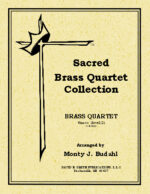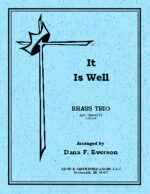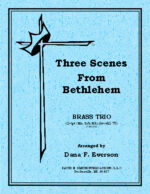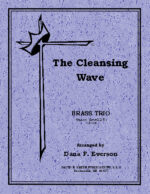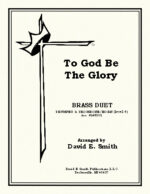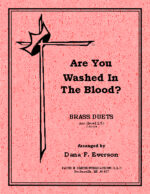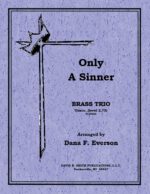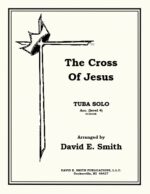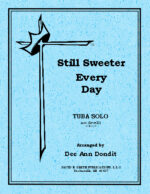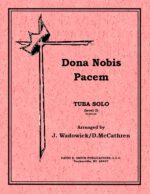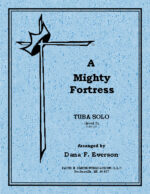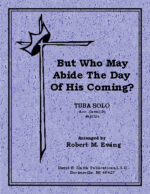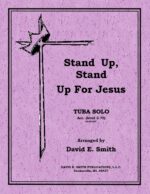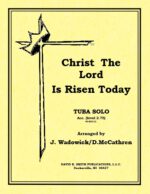-
Christmas Brass Quartet Collection
$15.95(2-tp, 2-Trb, hn/BH) -four pieces: Hark The Herald Angels It Came Upon A Midnight Clear; Angels We Have Heard On High; O Little Town Of Bethlehem
-
-
Holy, Holy, Holy
$7.00Written for Brass quartet, this pieces creates a solemn presence by the way it interweaves the various parts together. It would work well for a meditation.
-
Christ The Lord Is Risen Today
$9.00This is a brass trio with piano accompaniment. The brass scoring is for trumpet, horn or flugel horn, and trombone or baritone. The style is presented in a majestic manner first in block harmonies and then in a hocket structure. After a florid manner the piece follows a somewhat straight forward manner using fanfare motives in the upper parts the motion becomes more imitative. The final section is quite imitative and uses an overlayering of parts producing enjoyable passing around of the tune in a contrapuntal manner. With a final fanfare the piece concludes.
-
It Is Well
$9.00This brass trio is score for trumpet, horn (with trumpet sub), trombone (with Bar. TC sub) and piano. It is a piece that features the trombone part musch as a soloist. It begins with an open sound in the horn and piano with motives passed around amongst the brass parts. The middle section is more active with obligati passages that are responsoral with a concluding section that gives a sense of peace.
-
-
Three Scenes From Bethlehem
$9.00A brass trio for trumpet, horn and trombone with opt. Trp. And baritone parts which is rather unique. The piece is a medley of “O Little Town Of Bethlehem,” “We Three Kings,” and “Joy To The World.” The piece optionally incorporates read scripture…
-
Only A Sinner
$8.00A brass trio scored for trumpet, horn (opt. trp.) and trombone, (opt BHTC), The introduction opens with a motive that is passed amongst the three parts, The first presentation of the tune is likewise fragmented and passed around the ensemble giving a lot of interest- this carries on throughout the whole first section. The second section’s emphasis is given to the trombone and later handed over to the upper voices. A modulation takes place where the style is much like the introduction. This continues on until the coda where it begins quietly and builds to a statement of affirmation.
-
In The Garden
$8.00A brass trio for trumpet, horn and trombone with optional parts for trumpet and baritone. A somewhat straightforward piece from the standpoint of melody but it has a constantly evolving sense of texture. It’s as if a person were walking through a garden and reflecting on the surroundings and the implications of what they mean.
-
Blessed Be The Name
$9.00For two trumpets, trombone, and piano, this brass trio is much in the style of a march. The tune is passed around amongst the parts giving color, while at other times the parts move in a very triadic fashion. It would serve well as a special number.
-
The Cleansing Wave
$8.00A brass trio scored for trumpet, horn (opt. trp.) and trombone, (opt BHTC), the introduction uses the opening passes of the hymn and then modulates upward to the hymn now harmonized where it modulates even further now with more counterpoint amongst the voices. The middle section of the work modulates even further to a rather fughetta like setting. After yet another modulation the piece introduces music from “Jesus Paid It All” and then motivically develops to the Coda where the piece ends in repose.
-
To God Be The Glory
$6.00This duet with piano uses some expressive, interactive cadenza work between the duet parts in the beginning and during the work. It is vigorous in nature otherwise and ends with a torrent of joy!
-
Power And Glory Medley
$6.00An accompanied brass duet for trumpet and trombone (Opt. horn and Baritone). A brief introduction in the piano gives readily to the duet lines presenting the melody (Power In The Blood) alternated by phrase. A short transition and the trombone presents new material based on (Glory To His Name) giving over to the trumpet to complete it. A change of pace leading up to a modulation and now a cheerful rendition (Heaven Came Down) presented in an imitation format. Little motifs of the theme construct the Coda where it leads to an uplifting conclusion.
-
Are You Washed In The Blood?
$5.00This piece is scored for trumpet, trombone, and piano with optional horn and baritone parts. The piece is presented in a vigorous manner with the melodic material passed back and forth between the duet parts.
-
What A Friend
$5.00An unaccompanied brass duet for trumpet and trombone (opt. Horn) This pieces uses subtle imitative devices and moving counterpoint between the parts. It ends with a sense of quiet confidence.
-
Guide Me, O Thou Great Jehovah
$5.00This is an unaccompanied brass duet written in a majestic style with melodic alterations. At times interest is added by the imitative interplay of parts and continues so until the final statement.
-
The Cross Of Jesus
$6.00A tuba solo which begins with a sense of agony in the piano using the tune of “Beneath The Cross Of Jesus.” The solo then makes a declamatory statement and then becomes very expressive in a recitative-like section. This section is expressive and then becoming more vigorous using thematic material from “At The Cross.” After another transition the piece become vibrant using the theme of “The Cross Is Not Greater than His Grace.” A swift modulation and a faster tempo the piece ramps up a vigorous flair where it elevates to a strong crescendo including some triple tongue motives.
-
My Anchor Holds
$4.50This solo is in a march style throughout. It begins with little fanfare figures in the piano and then as it progress the soloist and piano exchange rolls. The second section is in a variation style while the third section is more expressive. The final section is more boisterous ending on a solid footing.
-
Dona Nobis Pacem
$4.50This tuba solo begins with a brief motif in the piano and then begins a series of variations and the soloist presents the theme. The variations are sometimes florid, other times plaintive, some times imitative and finally bold.
-
A Mighty Fortress
$4.50This tuba solo begins with melodic variation with various rhythmic devices. The middle section augments the melody, and then concludes much the way it began.
-
But Whom May Abide The Day…
$4.00Taken from the “Messiah”, this solo with piano is essentially a transcription of the original work. It features sufficient counterpoint between the various instruments.
-
Lead On O King Eternal
$4.50Originally in a duple meter this arrangement very cleverly is in a 6-8 march style. It progresses in a rather processional manner and then transitions to a slower reflective expression. The piece returns to its former style and then ends on a declamatory note.
-
Christ The Lord Is Risen
$5.50A brass solo in a Theme and Variation form. It starts out with a joyous introduction and then breaks into an antiphonal set of response of the tune. The first variation is essentially a descant while the piano carries the tune. The second variation is more contrapuntal in the piano while the solo carries on a fanfare-like obbligato. After a brief transition the piece concludes with a bold statement of the tune while being under-pinned with a walking bass line.


